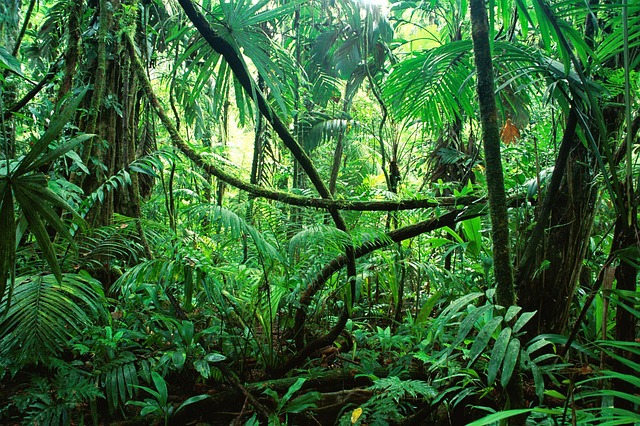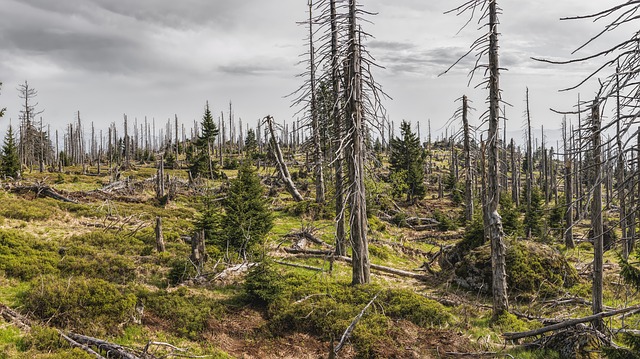A team of American, Norwegian and Chinese researchers has shown that CO2 emissions have contributed to an upsurge in vegetation growth since 1981. But is this necessarily good news? Yes, excess carbon is creating the conditions for growth in vegetation, but this greening is occurring alongside rising temperatures, melting ice caps and more intense rainfall, all of which cancel out the buffer effect of greater forest cover. This recent study, which was published in Nature Earth & Environment, offers an original, informed and discerning perspective of issues relating to the greenhouse effect.
The greening of the planet

Over the past forty years, humans have worked to grow vegetation, reduce deforestation and increase re-forested areas. Between 2000 and 2017, plant cover has grown by 4 million km2, an area equivalent to the Amazon rainforest. With more luxuriant flora, there have been claims that our planet is being less adversely affected by the greenhouse effect than in the past. However, a recent study carried out by international experts flies in the face of this idea, arguing that greening is simply an unexpected result of carbon emissions from industrial activities. An increasingly green world is not synonymous with a healthy ecosystem.
Satellite image surveys were collected over several years to measure spatiotemporal changes in vegetation. Amongst other things, the study focussed on the quantity of light energy intercepted by plants and the leaf area index. Plant cover is growing by 2.3% every ten years, worldwide. The findings of the study are indisputable:
- the spectacular increase in plant cover in Europe is due to the fertilising effects of CO2;
- In the South, flora is not growing so quickly, and CO2 has competition from other drivers, such as the arrival of intense rainfall after the dry season in the Sahel countries;
- In terms of land use, agriculture, prairies and logging represent 66% of vegetation growth, far ahead of re-forestation (less than 33%).
Scientists refer to this phenomenon as “greening”.
Carbon emissions are driving vegetation growth
According to NASA estimates in 2019, almost 75% of greening worldwide is due to rising greenhouse gas emissions. CO2 plays a dual role in vegetation growth: first, it is used in photosynthesis. As CO2 accumulates, reaction centres containing green chlorophyll pigments absorb more photosynthetically active sunlight. What happens is a straightforward chemical reaction: more photosynthesis means more organic matter. More organic matter means more greenery.
Secondly, carbon has an indirect greening effect by preventing loss of water. When the air fills with excessive quantities of carbon, plants close their stomas, the pores on the underside of leaves which facilitate gas exchange with the ambient air. Instead, the plants draw water from the soil for hydration. Transpiration is reduced, the plant draws on water stored in its tissue, and the absorbent function of roots is used correctly. The management of evaporation eliminates a factor which limits the growth of plants in arid and sub-arid ecosystems. Furthermore, nutrients are better absorbed, thus improving plant production.
Discrepancies between regions

While plant growth is, indeed, increasing worldwide, the pace of growth differs from one region to another. The highest levels of growth can be observed in very cold regions: the northern parts of Alaska and Canada, the subarctic tundra covering Siberia, Scandinavia and Eastern Canada. For example, vegetation in Svalbard grew by 30% between 1986 and 2015.
After polar regions, greening is most pronounced at temperate latitudes. Intensive farming zones in India and China lead the way. These two countries alone are responsible for 30% of the growth in world leaf area. China’s ambitious forest protection and re-foresting programme should be noted. Since 2000, greening has been occurring more rapidly in these regions than in boreal ecosystems.
In tropical regions, the major centres of greening are Australia, the Sudan-Sahel region and sub-Saharan Africa. It is difficult to accurately estimate the scale of greening within this region. The report claims that almost 25% of greening took place in tropical regions, but this figure is likely an estimate: in dense forests, leaves grow on top of each other, and this cannot be properly captured remotely. Whatever the exact figure, tropical ecosystems do not benefit from the positive effects of carbon on photosynthesis in the same way as in temperate biomes, because higher temperatures stymie the metabolisms of the plants. In these regions, ambient temperature is close to optimal for vegetation and, in some arid regions, it is already close to the upper limit of heat tolerance.
The effects of greening
Given the “buffer effect” of greening on global rises in temperature, the study could be taken to suggest that the greening process is good news. This, however, is only partly true.
Vegetation growth has slowed the rate of global warming by 0.2 to 0.25o C
It is widely acknowledged that the denser vegetation is, the more it creates carbon sinks. Almost 29% of human-made CO2 emissions have been captured by these sinks since 1981, and researchers estimate that temperatures will rise by 0.2o to 0.25o C less as a result. “It is ironic that the very same carbon emissions responsible for harmful changes to the climate are also fertilising plant growth, which in turn is somewhat moderating global warming”, notes the Norwegian doctor Jarle Bjerke, one of the authors of the study.
The environmental cost of CO2 emissions
However, this is to forget that greening comes with an environmental cost: it is an incredible example of the ecosystem adapting to and defending itself against atmospheric pollution, but the solution falls short of what is required. To cast greening in an exclusively positive light is to overlook the fact that higher temperatures have, in part, caused this phenomenon (in particular in Nordic regions, where plants now enjoy a longer flowering season). These rising temperatures bring with them a raft of problems including rising sea levels, drought, lower levels of rainfall and more irregular rainfall.
Re-forestation is no panacea
 Let us not stick our heads in the sand by suggesting re-forestation alone as a sustainable and adequate response to climate change. It takes one to three centuries for forests to recover from anthropogenic damage and return to their initial distribution of species in the undergrowth and mountains. To reach pre-clearance rates of endemicity, it will take at least a thousand years. In other terms, greening will never make up for damage caused to natural vegetation from the perspective of ecosystem sustainability and biodiversity. Finally, high levels of greening in the North are disturbing Arctic fauna, such as polar bears. According to biologist Andrew Derocher, who teaches at the University of Alberta, bears risk seeing their prey disappear (baby seals swimming near the surface of the ice) and will go extinct if the ice floe melts.
Let us not stick our heads in the sand by suggesting re-forestation alone as a sustainable and adequate response to climate change. It takes one to three centuries for forests to recover from anthropogenic damage and return to their initial distribution of species in the undergrowth and mountains. To reach pre-clearance rates of endemicity, it will take at least a thousand years. In other terms, greening will never make up for damage caused to natural vegetation from the perspective of ecosystem sustainability and biodiversity. Finally, high levels of greening in the North are disturbing Arctic fauna, such as polar bears. According to biologist Andrew Derocher, who teaches at the University of Alberta, bears risk seeing their prey disappear (baby seals swimming near the surface of the ice) and will go extinct if the ice floe melts.
A call for more proactive politics to face up to climate change
“Greening is the most resounding proof of the terrible consequences that industrial and human activities can have on the earth’s climate”, conclude Shilong Piao and Xuhui Wang, of Peking University. Taken in isolation, it would seem to be a good thing, but its many interactions with the hydrologic cycle, soil humidity, water flows, spatial distribution of rain and rising temperatures all indicate a tipping point has been reached. Far from contradicting the predictions of the IPCC, hard data from this study actively confirms them. Indeed, these findings provide further grounds for limiting global temperature rises to below 1.5 to 2o C.
Source: Shilong Piao, Xuhui Wang, Taejin Park, Chi Chen, Xu Lian, Yue He, Jarle W. Bjerke, Anping Chen, Philippe Ciais, Hans Tømmervik, Ramakrishna R. Nemani and Ranga B. Myneni, 9 December 2019, Nature Reviews Earth & Environment



